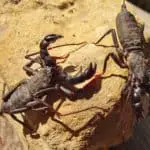If you are looking for a camel spider care guide, you are at the right place. In this guide, I’ll teach you how to keep camel spiders, aka solifuges.
Keep the camel spiders in a ventilated tank with a secure lid and 3-5″ substrates. Feed it with 1-2 crickets and water a corner of the substrates weekly. Females die soon after laying eggs. Separate the brood into individual containers after they molt. Feed them frequently with smaller insects.
Continue reading if you want to know more on how to care for camel spiders.
Introduction to Camel Spiders
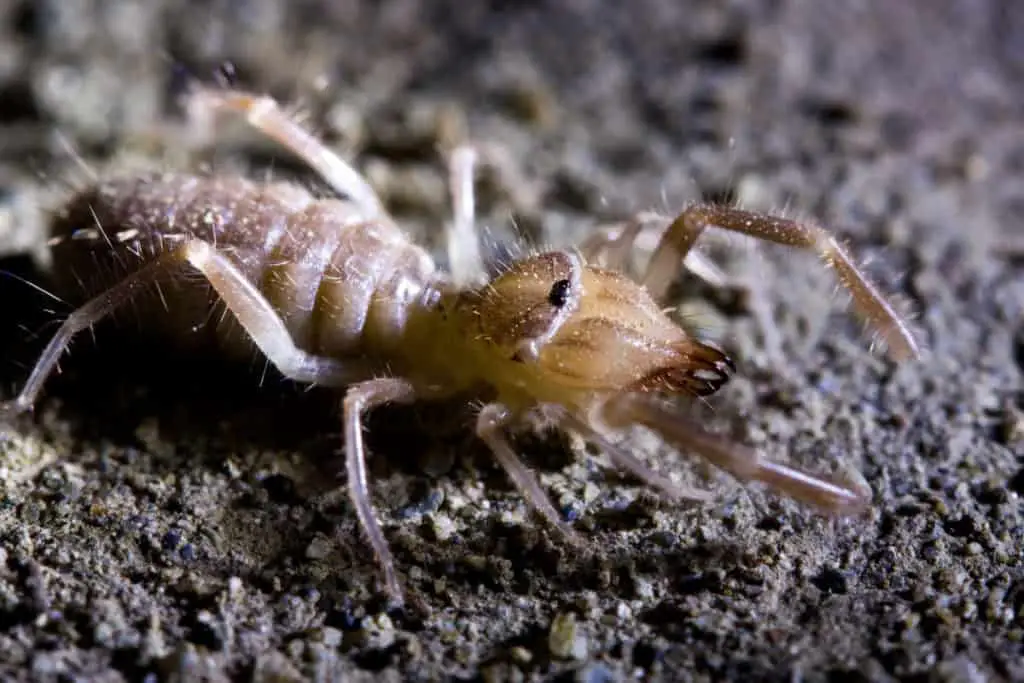
Camel spiders, also go by the alias sun spider, wind scorpion or solifuges, is a group of arachnids under the order Solifugae. They are neither scorpions nor spiders.
There are a lot of myths surrounding the camel spiders. Things like they jump onto a camel and cut the camel stomach open to feed on the organs; they chase after humans; they can outrun the Olympic sprint champions; they eat humans while we are sleeping; they are venomous etc. All those are not true.
Camel spiders can be found mainly in tropical and subtropical deserts. Most of the species are nocturnal where they hide in burrows during the day and are active at night.
Camel spiders have relatively big jaws which are called the chelicerae. They use their strong jaws to tear their prey apart. In nature, their prey includes various beetles, bugs, moths etc. They might even consume carcasses of dead animals.
At a glance, camel spiders seem to have 5 pairs of legs, but they actually have only 4 pairs of legs. The pedipalps of camel spiders are modified into a pair of long feelers that resemble legs. But if you take a closer look, you should notice they rarely touch the ground.
The long pedipalp feelers are used to detect prey, water, and perhaps potential mating partners. On the tip of the pedipalps, there is a suctorial organ. The camel spiders utilize the suctorial organ to climb smooth surfaces and to grasp their prey.
The first pair of legs are adapted for sensory purposes to support the pedipalps. Hence, the camel spiders rely mostly on the last 3 pairs of legs for locomotion. There are also some sensors called the malleoli or racquet organs located on the last pair of legs.
Although camel spiders can move very fast, they are harmless to humans because they are not venomous, they don’t sting, and they don’t bite unless agitated or threatened.
Generally, adult camel spiders live not more than 1 year. Male camel spiders die shortly after they mate.
Adult camel spiders measure 1-2” in body length.
Getting Camel Spiders
You should be able to easily source camel spiders by doing a Google search or via social media platforms if you stay in the US, since there are a few species native to the US.
Examples of species that you can get from the US are Eremobates lapazi from California, Eremocosta striata and Ammotrechula pilosa from Arizona, Eremorhax mumai from Colorado, Eremorhax magnus from Texas and more.
Almost all camel spiders sold are wild-caught partly because this creature is not well studied, they are short-lived and they are not as popular as other exotic pets.
If possible, get a juvenile camel spider instead of an adult to avoid getting an individual which is too old.
Enclosure Setup
House your camel spider in a ventilated tank with a secure lid. Lay 3-5” depth substrates. Make the substrates slightly moist and put in a water dish.
Camel spiders are good climbers thanks to the suctorial pad underneath their pedipalps. Make sure your enclosure has a secure lid to prevent it from escaping! You can read more about enclosure in this article.
Camel spiders spend most of their time in the burrow. Hence, you need to give them adequate substrates.
For substrates, you can mix potting soil, peat moss and soil. Add some water to make the substrates slightly moist but not overly wet. This will prevent the burrow from collapsing as your camel spider builds the burrow.
While camel spiders live in the desert, they sure need water to survive. Don’t use a deep water dish to prevent your Camel spiders from drowning. You can add some pebbles to the water dish so that any feeder insects who fall into the water dish can escape.
Add some cork bark or cactus skeleton into the tank to increase the surface area for your Camel spiders to climb and explore.
Camel spiders need to be housed individually in separate tanks to prevent cannibalism.
Microclimates
As a creature living in the deserts, camel spiders can tolerate extreme temperatures. You just need to keep them under room temperatures and they will survive well.
You also don’t need to be worried about humidity since they can tolerate dryness.
Water the substrates at one corner of the tank on a weekly basis to create a humidity gradient across the substrates. The camel spiders can then choose to stay where it is most comfortable.
Since camel spiders are mainly nocturnal, they don’t need additional lighting. You should put them away from direct light. When you want to observe them, you can use an LED display light and turn it off after you have finished watching them.
How to Feed Camel Spiders?
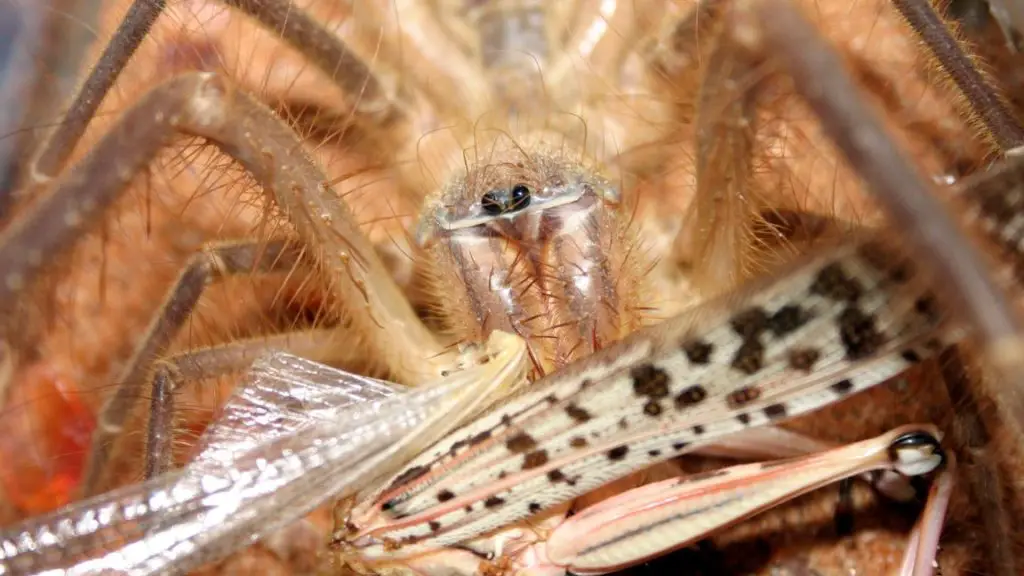
On a weekly basis, give your camel spiders 1-2 crickets or roaches at night. Remove any leftovers on the next day to prevent growth of mold. Remove the prey on the next day if the camel spider refuses to eat.
Camel spiders are able to handle prey as big as their body size. They catch their prey using their strong chelicerae and cut their prey into pieces. For tougher prey such as beetles that have strong exoskeleton, the camel spiders will cut their legs one by one to stop them from escaping, before munching them.
If you need help in maintaining a small colony of feeder insects to sustain your camel spider, check out my guide here.
If your camel spiders ignore the prey, potentially it is going to molt. Remove the prey and try feeding it again after a week, if it hasn’t molt yet.
Molting
Like other arthropods, camel spiders grow by molting. It takes nymphal 8 molts for the camel spiders to turn into adults.
When the camel spiders are about to molt, they stop feeding and moving. In the premolt phase, the camel spider positions it’s back on the floor, and its legs pointing upward. They may stay in such a position for months, as if they are dead. When the right conditions are met (albeit unknown at the moment), the molt will proceed.
Don’t disturb or touch your camel spider when you see it in the premolt stage. Don’t introduce any feeder insects either. The camel spider is extremely vulnerable at this stage.
Even if you are really concerned and wonder if it is dead, don’t touch it. Touching the pre-molting Camel spider will not tell you whether it is still alive because it will not move during the premolt! You may end up killing the camel spider by sabotaging the molting process through touching it! If it has indeed died, its body will start to dehydrate and wrinkle. If you don’t see that, it’s likely the camel spider is still alive.
A week after your camel spider completes molting, you can resume the feeding regime.
How to Breed Camel spiders?
Breeding camel spiders can be difficult because this subject is not well understood at the moment.
In short, you have to introduce the adult male into the tank with adult female camel spiders. If the conditions are right, they mate. If not, the male could be eaten by the female.
Be sure to feed the pair one day before letting them mate. This should hopefully reduce the chance of the male being harmed by the female camel spider.
Male vs Female Camel Spiders
Other than those of the family Eremobatidae, the male Camel spiders have a threadlike flagellum on each upper chelicera. Male also have fewer teeth on their jaws.
Other than that, female Camel spiders are bigger in size, have curvier upper jaws, rounder opisthosoma and smaller racquet organs underneath the rear legs.
Racquet organs, also known as malleoli are sensors located underneath the rear legs of the camel spiders. They use this organ to find water, detect pheromones of the opposite sex, and trace their prey. They look like an inverted “T” (refer to the photo below).
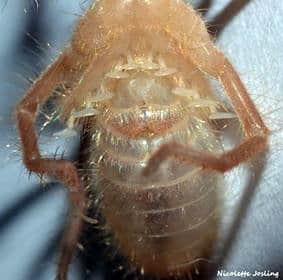
The Mating Process
The camel spider pair starts to mate after they have gone through the formal “introduction” process, if the female is receptive.
With the help of his jaws, the male camel spider will open up her genitals at the underside of her body so that he can deposit his sperm directly into her genital. Once he is done, he will quickly escape to avoid becoming a meal.
In certain non-American species, the male camel spider deposits his sperm in a spermatophore on the floor, which is then picked up by the female.
How to Care for the Camel Spiders Brood

Gravid females need more food for more nutrients to develop their eggs. You can increase the number of crickets or roaches provided to her. The moment she stops eating, she is ready to lay her eggs. By then, you should be able to see the eggs through her translucent opisthosoma (abdomen).
The gravid female digs a shallow burrow to lay her eggs. Depending on species, she may lay between 15-150 eggs, and she may leave the eggs or take care of them till they hatch. In most US species, the female Camel spiders die soon after laying eggs.
The eggs hatch into the post-embryo stage or larvae after a few weeks. These larvae stay in the burrow for 2 weeks before they molt for the first time into the 1st instar nymph. There are 8 nymphal instars before the adult stage.
Similar to the larvae, the 1st nymphal instars don’t eat anything. They rely on the nutrients in their body to grow.
After the second molt, the camel spiders become more active and start to hunt for food. They also start to attack each other. You need to start separating them into different containers.
Feed the juvenile camel spiders twice a week with pinhead crickets or roaches. Increase the size of feeder insects as they molt and gradually reduce the feeding frequency to weekly.
Handling Camel Spiders
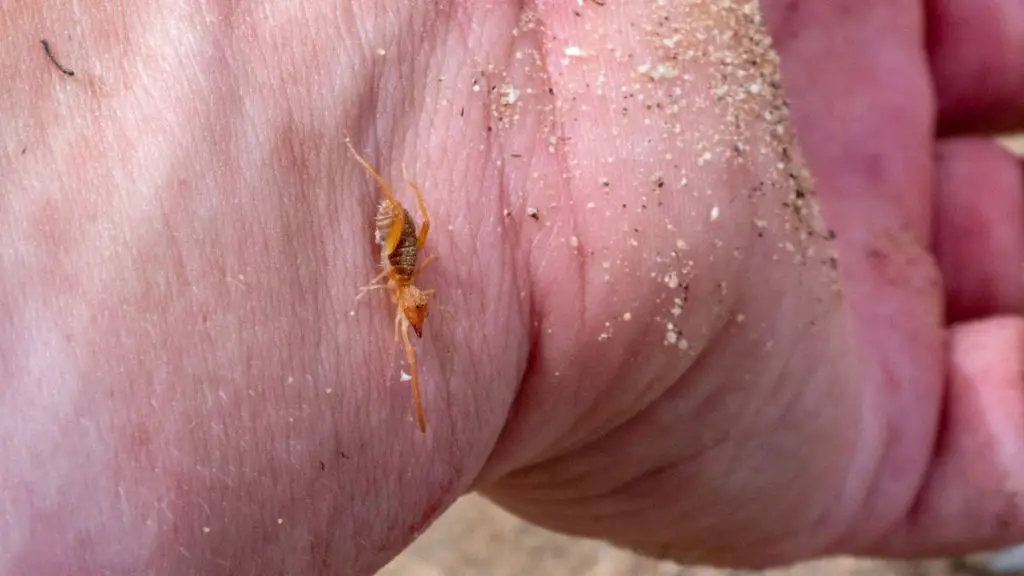
Camel spiders can be easily handled since they are not venomous, they don’t sting, and they rarely bite. However, they can move really fast.
The bite from a camel spider may or may not cut your skin. It is painful for sure. If you get bitten, clean your wound with water and cover it with a band aid if it bleeds.
Recommended Reading
If you want to read more about keeping Camel spiders, I recommend you to get the book titled Scorpions, Windscorpions, Pseudoscorpions: Culturing Ancient Arachnids by Orin McMonigle. It covers all you need to know about camel spiders (known as windscorpion in that book) from a hobbyist perspective. Although this book is dated and doesn’t include some new findings on camel spiders, it is the only useful book on camel spiders that is available in the market at the moment.
Recommended Supplies
Here are my recommended supplies that you can consider for keeping sun spiders. Note that I get a small commission when you buy the items through the links in this page. This helps me maintain the site without incurring additional costs to you.

